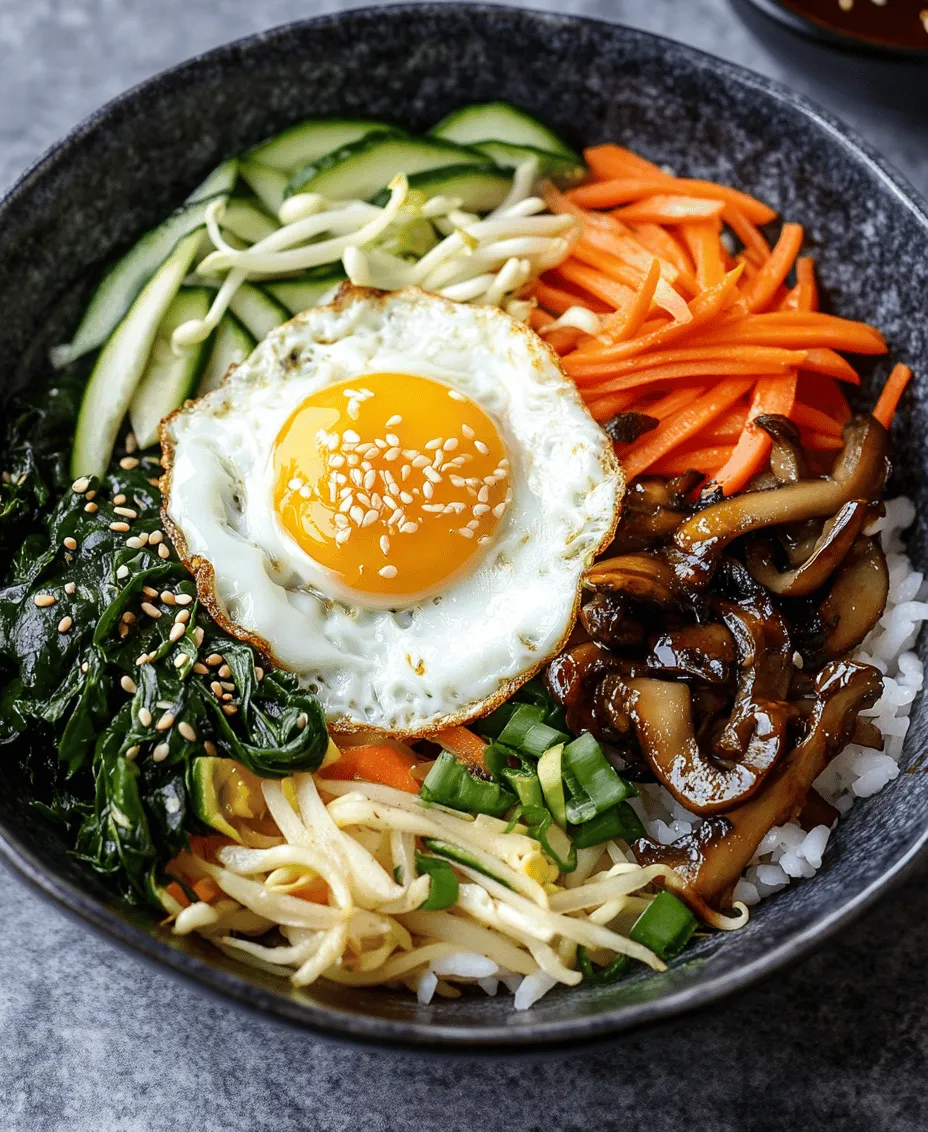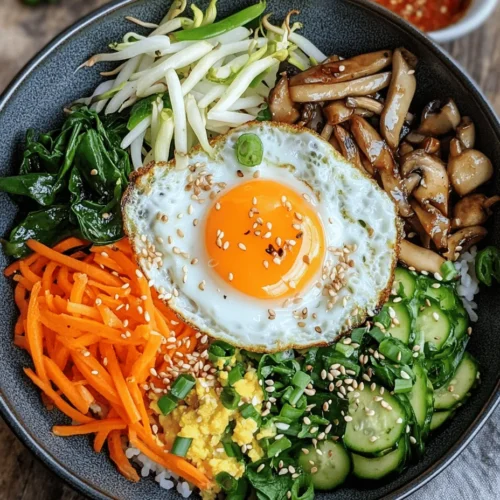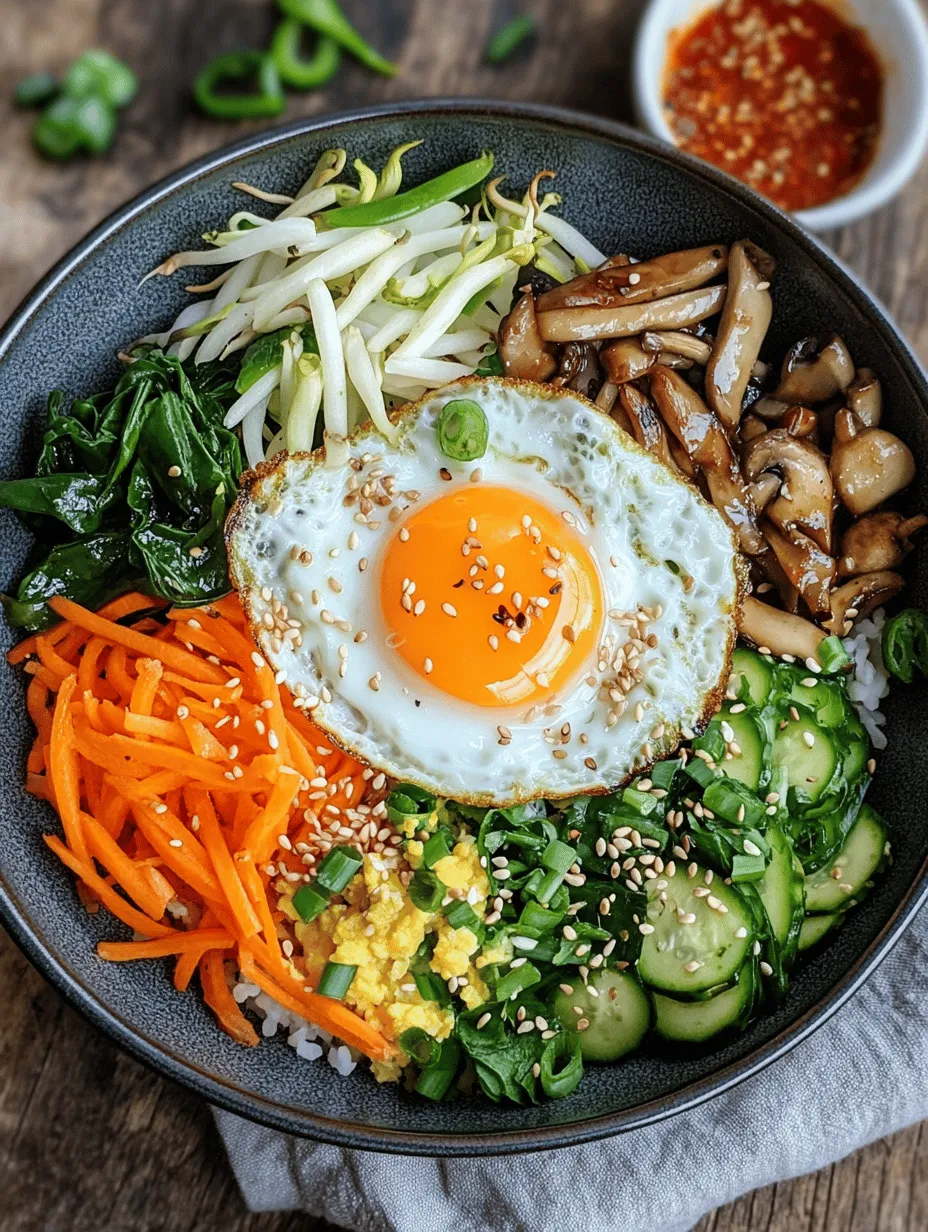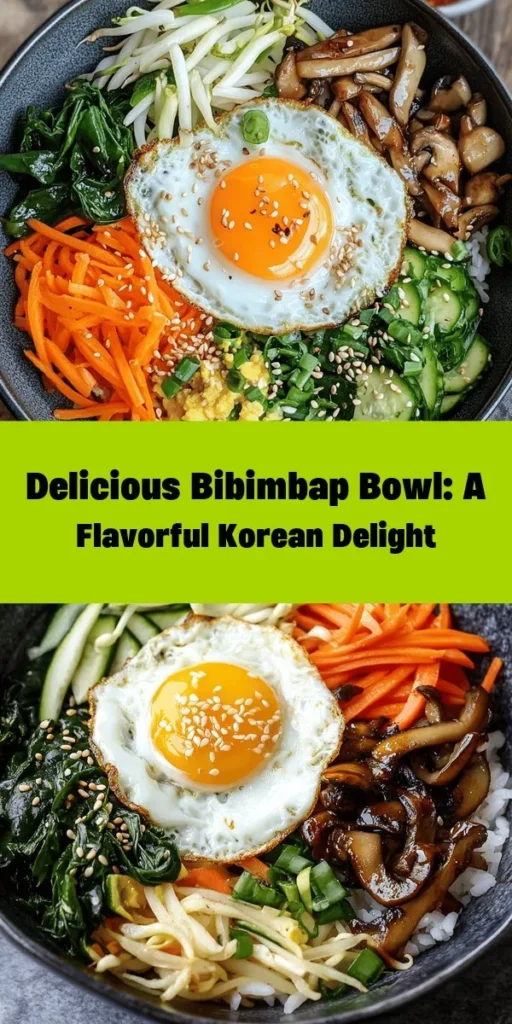Introduction
Bibimbap, a colorful and vibrant dish hailing from Korea, has earned its place as a beloved staple in both traditional and modern dining. This dish, which translates to “mixed rice,” is a harmonious blend of rice, vegetables, protein, and a spicy sauce, creating a culinary experience that is as delightful to the eyes as it is to the palate. The significance of bibimbap extends beyond its deliciousness; it is a reflection of Korean culture, symbolizing harmony, balance, and the importance of fresh ingredients. As this dish has gained global popularity, variations have emerged, allowing people from different culinary backgrounds to enjoy its unique flavors.
Our recipe, the “Bibimbap Bliss Bowl,” takes traditional bibimbap and elevates it into a healthy, satisfying meal that is perfect for any time of day. Packed with nutritious ingredients and a symphony of flavors, this blissful bowl is not only a feast for the senses but also a nourishing option for health-conscious eaters. Whether you are a long-time fan of Korean cuisine or a newcomer eager to explore, this recipe offers a delicious introduction to the world of bibimbap.
Understanding Bibimbap
Definition and History of Bibimbap
Bibimbap has a rich history that dates back to the late 19th century in Korea. Originally a dish for the common people, it has evolved into a celebrated meal enjoyed by all social classes. Traditionally served in a hot stone bowl, bibimbap features a base of rice topped with an assortment of sautéed and seasoned vegetables, meat, and a fried egg. The dish is often finished with a drizzle of gochujang, a fermented red pepper paste that adds a distinctive kick. The act of mixing the ingredients together before eating is integral to the bibimbap experience, symbolizing unity and balance.
Cultural Significance and Variations of Bibimbap Across Korea
Bibimbap is not just a dish; it represents a cultural narrative of Korea. Each region has its own variation, showcasing local ingredients and flavors. For instance, Jeonju bibimbap, famous for its use of quality ingredients and a variety of vegetables, is often regarded as the most authentic version. In contrast, the Yongin-style bibimbap incorporates local agricultural produce, reflecting the area’s agricultural heritage. The beauty of bibimbap lies in its adaptability, allowing it to cater to different tastes and dietary preferences, from vegetarian to meat-based versions.
Nutritional Benefits of Bibimbap as a Balanced Meal
A well-prepared bibimbap is a nutritional powerhouse. The combination of rice, vegetables, and protein creates a balanced meal rich in carbohydrates, vitamins, minerals, and healthy fats. The variety of vegetables not only adds color and texture but also provides essential nutrients. For example, spinach is high in iron and calcium, while carrots are a great source of beta-carotene. The addition of an egg contributes protein and healthy fats, making bibimbap a wholesome option for any meal. Furthermore, the use of gochujang adds depth of flavor and a small dose of spice, enhancing the overall taste profile without overwhelming the dish.
Key Ingredients of the Bibimbap Bliss Bowl
Creating the perfect Bibimbap Bliss Bowl requires a careful selection of ingredients to achieve that authentic taste while maintaining the dish’s health benefits. Here’s a closer look at the main components of this vibrant dish.
Rice
The foundation of any good bibimbap is rice, and for our Bibimbap Bliss Bowl, we recommend using jasmine or short-grain rice. These rice varieties are known for their sticky texture, which helps to hold the ingredients together when mixed. Jasmine rice, with its subtle floral aroma, adds an extra layer of flavor, while short-grain rice provides a slightly chewy consistency that enhances the overall eating experience. The choice of rice is crucial, as it serves as the blank canvas upon which the other flavors will shine.
Vegetables
An array of vegetables gives bibimbap its colorful presentation and nutritional value. In our Bibimbap Bliss Bowl, we will include:
– Spinach: A key ingredient that is rich in iron and vitamins A, C, and K. Blanched spinach adds a fresh, slightly earthy flavor to the dish.
– Carrots: Shredded or julienned, carrots provide a sweet crunch and are packed with beta-carotene, which is converted into vitamin A in the body.
– Zucchini: This mild-flavored vegetable adds moisture and a soft texture when sautéed, complementing the other ingredients.
– Bean Sprouts: Crunchy and refreshing, bean sprouts are low in calories while being high in fiber and vitamin C, making them a perfect addition to enhance the texture.
– Shiitake Mushrooms: Known for their umami flavor, shiitake mushrooms add depth and richness to the dish. They are also a great source of protein and B vitamins.
Eggs
Eggs play a significant role in bibimbap, contributing both protein and richness to the dish. Traditionally, a fried or poached egg is placed on top of the bibimbap just before serving. When mixed with the warm rice and vegetables, the yolk creates a creamy sauce that ties all the flavors together. For those seeking a vegan option, tofu can be used as a substitute, providing a similar texture and protein content.
Gochujang
No bibimbap is complete without gochujang, the iconic Korean red pepper paste. This fermented condiment is made from red chili powder, glutinous rice, fermented soybeans, and salt, creating a complex flavor that is both spicy and slightly sweet. Gochujang not only adds heat to the dish but also enhances the overall umami profile, making it an essential component of our Bibimbap Bliss Bowl.
Sesame Oil and Soy Sauce
To round out the flavors, sesame oil and soy sauce are used to enhance the dish’s umami and depth. Sesame oil, with its nutty aroma, adds richness and a touch of warmth, while soy sauce brings a savory element that balances the sweetness of the vegetables. Together, these ingredients create a harmonious blend of flavors that elevate the bibimbap experience.
Garnishes
Finally, garnishes such as sesame seeds and green onions add the finishing touch to the Bibimbap Bliss Bowl. Sesame seeds provide a delightful crunch and nutty flavor, while sliced green onions add a fresh, oniony bite that brightens the dish. These garnishes not only enhance the presentation but also contribute to the overall flavor profile of the bibimbap.
Step-by-Step Guide to Preparing the Bibimbap Bliss Bowl
Now that we’ve covered the essential ingredients, it’s time to dive into the preparation process for the Bibimbap Bliss Bowl. This step-by-step guide will help you create a delicious and visually appealing dish that is sure to impress family and friends.
Preparation of Vegetables
The first step in preparing your Bibimbap Bliss Bowl is to prepare the vegetables. Properly blanching and sautéing the vegetables ensures they retain their color, texture, and nutritional value.
1. Blanching Spinach:
– Begin by washing the spinach thoroughly to remove any dirt or grit.
– Bring a pot of water to a boil and add a pinch of salt.
– Once the water is boiling, add the spinach and blanch for about 30 seconds or until wilted.
– Remove the spinach from the boiling water and immediately transfer it to a bowl of ice water to stop the cooking process.
– After a few minutes, drain the spinach and gently squeeze out excess water. Set aside.
2. Preparing Bean Sprouts:
– Rinse the bean sprouts under cold water to cleanse them.
– In the same pot of boiling water used for the spinach, add the bean sprouts and blanch for about 2-3 minutes until they are tender but still crisp.
– Remove from the boiling water and transfer to the ice water bath, similar to the spinach. This helps retain their crunch.
– Drain and set aside.
3. Sautéing Carrots and Zucchini:
– Julienne the carrots and zucchini into thin strips.
– Heat a tablespoon of sesame oil in a skillet over medium heat.
– Add the carrots first, sautéing for about 2-3 minutes until they soften slightly.
– Next, add the zucchini to the skillet, cooking for an additional 2-3 minutes until both vegetables are tender yet retain their vibrant colors.
– Season with a splash of soy sauce, stirring to combine. Remove from heat and set aside.
4. Preparing Shiitake Mushrooms:
– Clean the shiitake mushrooms with a damp cloth and slice them thinly.
– In the same skillet, add a little more sesame oil if needed and sauté the mushrooms over medium heat until they are golden brown and tender, about 4-5 minutes.
– Season with a pinch of salt and remove from heat.
With the vegetables prepared, you’re now ready to assemble your Bibimbap Bliss Bowl. The next steps will guide you through the final assembly process, ensuring you create a delicious and visually stunning dish that showcases the vibrant ingredients you’ve prepared.

Tips for Julienning Carrots and Zucchini for Even Cooking
Julienning vegetables such as carrots and zucchini is essential for achieving uniform cooking in your Bibimbap Bliss Bowl. Here are some useful tips to help you julienne these vegetables efficiently:
1. Preparation: Start by washing your carrots and zucchini thoroughly. Peel the carrots to remove any dirt and skin. Trim both ends of the vegetables for a neat cut.
2. Cutting Technique: For even slices, first cut the carrot and zucchini into manageable lengths, about 3-4 inches. This will make it easier to handle. Next, slice each piece lengthwise into thin planks, about 1/8 inch thick. Stack a few planks together and slice them into thin strips, ensuring they are uniform in size. This method allows for even cooking and a pleasing presentation.
3. Use a Mandoline: If you want to save time and achieve perfect uniformity, consider using a mandoline slicer. Adjust the blade to your desired thickness for quick and efficient julienning.
4. Soaking in Water: After julienning, soak the carrot and zucchini strips in ice water for about 10-15 minutes. This process helps them retain their crunchiness during cooking, ensuring they complement the other ingredients in your bibimbap.
Cooking the Eggs
The eggs are a fundamental component of the Bibimbap Bliss Bowl, and how you cook them can greatly influence the overall experience of the dish. Here are some techniques to achieve the perfect egg:
Techniques for Achieving the Perfect Sunny-Side-Up Egg
1. Choose the Right Pan: A non-stick skillet is ideal for frying eggs, as it prevents sticking and allows for easy flipping if necessary.
2. Heat Control: Heat the skillet over medium-low heat. Adding the eggs too quickly can result in crispy edges while leaving the yolk undercooked.
3. Adding Oil: Use a neutral oil, like canola or vegetable oil, and let it heat for about 30 seconds before gently cracking the egg into the pan. You can also add a small pat of butter for extra flavor.
4. Covering the Pan: To achieve that perfect runny yolk without overcooking the whites, cover the pan with a lid. This traps the heat and steam, allowing the top of the egg to cook evenly without flipping.
5. Cooking Time: Cook for about 3-4 minutes until the whites are set and the yolk remains runny. If you prefer a firmer yolk, just cook for an additional minute or two.
Alternative Cooking Methods for Eggs
If you want to explore different textures and flavors, consider these alternative cooking methods for your eggs:
– Poached Eggs: Poaching provides a delicate texture. Bring a pot of water to a gentle simmer, add a splash of vinegar to help the egg hold its shape, and gently crack the egg into the water. Cook for about 3-4 minutes for a runny yolk.
– Scrambled Eggs: For a different take, whisk eggs with a pinch of salt and cook them in a non-stick skillet over medium heat, stirring gently until they are fluffy and just set.
Assembly Process
The assembly of your Bibimbap Bliss Bowl is where the magic happens. It’s not just about flavor but also about presentation. Here’s how to create a stunning dish:
Creative Plating Techniques for an Aesthetically Pleasing Dish
1. Base Layer: Begin by placing a serving of warm rice at the bottom of the bowl. This acts as the foundation for all other ingredients.
2. Layering Ingredients: Arrange your julienned vegetables (carrots, zucchini, and any others you’ve prepared) in a circular pattern or in sections on top of the rice. This layering not only looks appealing but also allows for a balanced flavor in each bite.
3. Egg Placement: Gently place your cooked egg on top of the vegetables. If you’ve chosen sunny-side-up, let the yolk sit proudly in the center, creating a beautiful focal point.
4. Garnishing: Finish your bowl with a sprinkle of sesame seeds, chopped scallions, or seaweed flakes for added texture and flavor.
5. Final Touches: A drizzle of gochujang or a side of it can be placed on the side for those who prefer to control their spice level.
Importance of Layering Ingredients for Balanced Flavor and Texture
Layering your ingredients is crucial for achieving the perfect bite. The warm rice absorbs the flavors from the vegetables and the egg, while the fresh textures of the julienned vegetables contrast beautifully with the creamy yolk. Each ingredient should be vibrant and distinct, contributing to the overall experience of the bibimbap.
Finishing Touches
To elevate your Bibimbap Bliss Bowl, consider these finishing touches:
Recommendations for Adjusting the Level of Spice with Gochujang
Gochujang is a fermented Korean chili paste that adds depth and spice to your bibimbap. Here’s how to adjust the spice level to your preference:
– Mild: Start with a small dollop of gochujang on the side of the bowl. This allows diners to mix it in gradually, controlling the heat.
– Medium: Mix a teaspoon of gochujang directly into the dish or on top of the egg. This will provide a noticeable kick without overwhelming the other flavors.
– Spicy: For those who love heat, mix a tablespoon of gochujang with a splash of sesame oil and drizzle it generously over the entire bowl.
How to Personalize the Dish According to Taste Preferences
Bibimbap is highly customizable. Feel free to personalize your bowl with various ingredients based on dietary preferences or availability:
– Vegetables: Incorporate seasonal vegetables such as spinach, mushrooms, or bean sprouts. These can add different textures and flavors.
– Proteins: For a heartier meal, add marinated beef, chicken, or tofu. You can also substitute the egg with a fried tofu block for a vegan option.
– Sauces: Experiment with other sauces like soy sauce, sriracha, or even tahini to create unique flavor profiles.
Nutritional Analysis of the Bibimbap Bliss Bowl
Understanding the nutritional content of your meal is essential for health-conscious eaters. Here’s a breakdown of the Bibimbap Bliss Bowl:
Breakdown of Calories and Macronutrients per Serving
– Calories: Approximately 450-600 calories per serving, depending on the ingredients used.
– Carbohydrates: 70-80 grams, mainly from rice and vegetables.
– Proteins: 15-20 grams, coming from eggs and optional protein additions like meat or tofu.
– Fats: 10-15 grams, primarily from the oil used in cooking and the egg.
Health Benefits Associated with the Ingredients Used
Each ingredient in the Bibimbap Bliss Bowl offers health benefits:
– Brown Rice: A whole grain that provides fiber and essential nutrients.
– Vegetables: Packed with vitamins, minerals, and antioxidants, contributing to overall health and vitality.
– Eggs: A rich source of protein and beneficial fats.
– Gochujang: Contains beneficial probiotics due to fermentation, promoting gut health.
Discussion on the Balance of Carbohydrates, Proteins, and Fats
This dish provides a well-rounded macronutrient profile. The carbohydrates from rice supply energy, while the protein from eggs and additional toppings helps in muscle repair and growth. Healthy fats from cooking oil and egg yolks support hormone production and nutrient absorption, making this bibimbap not just a delicious meal but a nutritious one.
Serving Suggestions and Pairings
Enhance your Bibimbap experience by considering these serving suggestions and pairings:
Ideas for Side Dishes that Complement the Bibimbap
1. Kimchi: The classic Korean side dish adds a spicy and tangy flavor that contrasts beautifully with the bibimbap.
2. Pickled Vegetables: Quick pickles made from radishes or cucumbers can add a refreshing crunch.
3. Seaweed Salad: A light seaweed salad can provide a unique texture and flavor profile.
Beverage Pairings that Enhance the Meal Experience
1. Korean Teas: Herbal teas like barley or corn tea can cleanse the palate and complement the dish.
2. Soju: For an adult beverage, soju is a traditional Korean spirit that pairs well with bibimbap, enhancing the cultural experience.
Conclusion
Bibimbap is more than just a dish; it is a celebration of flavors, textures, and cultural heritage. Each ingredient contributes to a culinary experience that is both satisfying and visually appealing. By making this dish at home, you not only enjoy the delightful mix of tastes but also connect with the rich traditions of Korean cuisine.
As you explore variations of the Bibimbap Bliss Bowl, let your creativity flow. Whether you prefer it spicy or mild, loaded with vegetables or proteins, the possibilities are endless. So gather your ingredients, follow the steps, and savor the joy of creating this delightful Korean meal in your kitchen.



